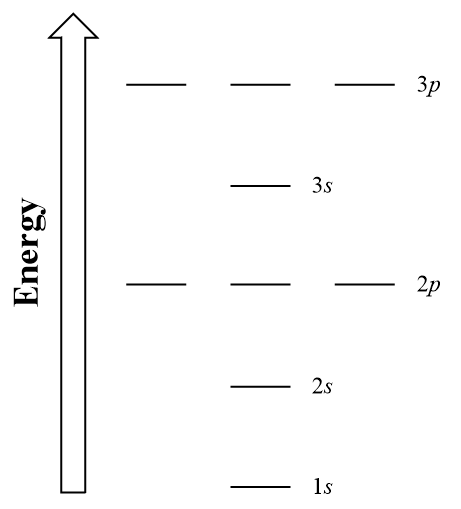Electronic Wavefunctions (Worksheet)
- Page ID
- 63806
\( \newcommand{\vecs}[1]{\overset { \scriptstyle \rightharpoonup} {\mathbf{#1}} } \)
\( \newcommand{\vecd}[1]{\overset{-\!-\!\rightharpoonup}{\vphantom{a}\smash {#1}}} \)
\( \newcommand{\dsum}{\displaystyle\sum\limits} \)
\( \newcommand{\dint}{\displaystyle\int\limits} \)
\( \newcommand{\dlim}{\displaystyle\lim\limits} \)
\( \newcommand{\id}{\mathrm{id}}\) \( \newcommand{\Span}{\mathrm{span}}\)
( \newcommand{\kernel}{\mathrm{null}\,}\) \( \newcommand{\range}{\mathrm{range}\,}\)
\( \newcommand{\RealPart}{\mathrm{Re}}\) \( \newcommand{\ImaginaryPart}{\mathrm{Im}}\)
\( \newcommand{\Argument}{\mathrm{Arg}}\) \( \newcommand{\norm}[1]{\| #1 \|}\)
\( \newcommand{\inner}[2]{\langle #1, #2 \rangle}\)
\( \newcommand{\Span}{\mathrm{span}}\)
\( \newcommand{\id}{\mathrm{id}}\)
\( \newcommand{\Span}{\mathrm{span}}\)
\( \newcommand{\kernel}{\mathrm{null}\,}\)
\( \newcommand{\range}{\mathrm{range}\,}\)
\( \newcommand{\RealPart}{\mathrm{Re}}\)
\( \newcommand{\ImaginaryPart}{\mathrm{Im}}\)
\( \newcommand{\Argument}{\mathrm{Arg}}\)
\( \newcommand{\norm}[1]{\| #1 \|}\)
\( \newcommand{\inner}[2]{\langle #1, #2 \rangle}\)
\( \newcommand{\Span}{\mathrm{span}}\) \( \newcommand{\AA}{\unicode[.8,0]{x212B}}\)
\( \newcommand{\vectorA}[1]{\vec{#1}} % arrow\)
\( \newcommand{\vectorAt}[1]{\vec{\text{#1}}} % arrow\)
\( \newcommand{\vectorB}[1]{\overset { \scriptstyle \rightharpoonup} {\mathbf{#1}} } \)
\( \newcommand{\vectorC}[1]{\textbf{#1}} \)
\( \newcommand{\vectorD}[1]{\overrightarrow{#1}} \)
\( \newcommand{\vectorDt}[1]{\overrightarrow{\text{#1}}} \)
\( \newcommand{\vectE}[1]{\overset{-\!-\!\rightharpoonup}{\vphantom{a}\smash{\mathbf {#1}}}} \)
\( \newcommand{\vecs}[1]{\overset { \scriptstyle \rightharpoonup} {\mathbf{#1}} } \)
\( \newcommand{\vecd}[1]{\overset{-\!-\!\rightharpoonup}{\vphantom{a}\smash {#1}}} \)
\(\newcommand{\avec}{\mathbf a}\) \(\newcommand{\bvec}{\mathbf b}\) \(\newcommand{\cvec}{\mathbf c}\) \(\newcommand{\dvec}{\mathbf d}\) \(\newcommand{\dtil}{\widetilde{\mathbf d}}\) \(\newcommand{\evec}{\mathbf e}\) \(\newcommand{\fvec}{\mathbf f}\) \(\newcommand{\nvec}{\mathbf n}\) \(\newcommand{\pvec}{\mathbf p}\) \(\newcommand{\qvec}{\mathbf q}\) \(\newcommand{\svec}{\mathbf s}\) \(\newcommand{\tvec}{\mathbf t}\) \(\newcommand{\uvec}{\mathbf u}\) \(\newcommand{\vvec}{\mathbf v}\) \(\newcommand{\wvec}{\mathbf w}\) \(\newcommand{\xvec}{\mathbf x}\) \(\newcommand{\yvec}{\mathbf y}\) \(\newcommand{\zvec}{\mathbf z}\) \(\newcommand{\rvec}{\mathbf r}\) \(\newcommand{\mvec}{\mathbf m}\) \(\newcommand{\zerovec}{\mathbf 0}\) \(\newcommand{\onevec}{\mathbf 1}\) \(\newcommand{\real}{\mathbb R}\) \(\newcommand{\twovec}[2]{\left[\begin{array}{r}#1 \\ #2 \end{array}\right]}\) \(\newcommand{\ctwovec}[2]{\left[\begin{array}{c}#1 \\ #2 \end{array}\right]}\) \(\newcommand{\threevec}[3]{\left[\begin{array}{r}#1 \\ #2 \\ #3 \end{array}\right]}\) \(\newcommand{\cthreevec}[3]{\left[\begin{array}{c}#1 \\ #2 \\ #3 \end{array}\right]}\) \(\newcommand{\fourvec}[4]{\left[\begin{array}{r}#1 \\ #2 \\ #3 \\ #4 \end{array}\right]}\) \(\newcommand{\cfourvec}[4]{\left[\begin{array}{c}#1 \\ #2 \\ #3 \\ #4 \end{array}\right]}\) \(\newcommand{\fivevec}[5]{\left[\begin{array}{r}#1 \\ #2 \\ #3 \\ #4 \\ #5 \\ \end{array}\right]}\) \(\newcommand{\cfivevec}[5]{\left[\begin{array}{c}#1 \\ #2 \\ #3 \\ #4 \\ #5 \\ \end{array}\right]}\) \(\newcommand{\mattwo}[4]{\left[\begin{array}{rr}#1 \amp #2 \\ #3 \amp #4 \\ \end{array}\right]}\) \(\newcommand{\laspan}[1]{\text{Span}\{#1\}}\) \(\newcommand{\bcal}{\cal B}\) \(\newcommand{\ccal}{\cal C}\) \(\newcommand{\scal}{\cal S}\) \(\newcommand{\wcal}{\cal W}\) \(\newcommand{\ecal}{\cal E}\) \(\newcommand{\coords}[2]{\left\{#1\right\}_{#2}}\) \(\newcommand{\gray}[1]{\color{gray}{#1}}\) \(\newcommand{\lgray}[1]{\color{lightgray}{#1}}\) \(\newcommand{\rank}{\operatorname{rank}}\) \(\newcommand{\row}{\text{Row}}\) \(\newcommand{\col}{\text{Col}}\) \(\renewcommand{\row}{\text{Row}}\) \(\newcommand{\nul}{\text{Nul}}\) \(\newcommand{\var}{\text{Var}}\) \(\newcommand{\corr}{\text{corr}}\) \(\newcommand{\len}[1]{\left|#1\right|}\) \(\newcommand{\bbar}{\overline{\bvec}}\) \(\newcommand{\bhat}{\widehat{\bvec}}\) \(\newcommand{\bperp}{\bvec^\perp}\) \(\newcommand{\xhat}{\widehat{\xvec}}\) \(\newcommand{\vhat}{\widehat{\vvec}}\) \(\newcommand{\uhat}{\widehat{\uvec}}\) \(\newcommand{\what}{\widehat{\wvec}}\) \(\newcommand{\Sighat}{\widehat{\Sigma}}\) \(\newcommand{\lt}{<}\) \(\newcommand{\gt}{>}\) \(\newcommand{\amp}{&}\) \(\definecolor{fillinmathshade}{gray}{0.9}\)Name: ______________________________
Section: _____________________________
Student ID#:__________________________
Work in groups on these problems. You should try to answer the questions without referring to your textbook. If you get stuck, try asking another group for help.
...and then there were Four
Solving the Schrödinger's equation for the hydrogen atom results in three quantum numbers: the principal quantum number (\(n\)), angular quantum number (\(l\)), and the magnetic quantum number (\(m_l\)). These quantum numbers describe the size, shape, and orientation of the spatial properties of the wavefunction. However, experimental evidence suggests that an atomic wavefunction can hold no more than two electrons.
To distinguish between the two electrons in an wavefunction, we introduce a fourth quantum number called the spin quantum number (\(m_s\)) because electrons behave as if they were spinning in either a clockwise or counterclockwise fashion. One of the electrons in an orbital is arbitrarily assigned an \(m_s = +1/2\) (called \(\alpha\)), the other is assigned a \(m_s = -1/2\) (called \(\beta\)). Hence, while it takes three quantum numbers to define an orbital, it takes four quantum numbers to describe a spin-orbital.
Q1
For the electron configuration described below, identify the four quantum numbers for each electron. Do you need more information?

Spin-Orbitals
The wavefunctions obtained by solving the hydrogen atom Schrödinger equation are associated with orbital angular motion and are often called spatial wavefunctions, to differentiate them from the spin wavefunctions. The complete wavefunction for an electron in a hydrogen atom must contain both the spatial and spin components. We refer to the complete one-electron orbital as a spin-orbital and a general form for this orbital is
\[ | \varphi _{n,l,m_l , m_s} \rangle = \psi _{2,1,0,+½} = | \psi _{n,l,m_l} (r, \theta , \psi ) \rangle | \sigma ^{m_s}_s \rangle \label {8.7.1}\]
A spin-orbital for an electron in the \(2p_z\) orbital with \(m_s = + \frac {1}{2} \), for example, could be written as
\[ | \psi _{2pz_\alpha} \rangle = \psi _{2,1,0,+½} = | \psi _{2,1,0} (r, \theta, \psi) \rangle | \alpha \rangle \label{8.7.2}\]
We can combine the 3-D coordinates (\((r, \theta, \psi)\)) for electron 1 as \(r_1\) and separate this "spin-orbital" into spatial and spin components:
- Spatial component: \[| 1s(1) \rangle = | \psi_{1s}(r_1) \rangle \]
- Spin component: \[|\alpha (1) \rangle \, \text{for } m_s=+\frac{1}{2}\] and \[ |\beta (1) \rangle \, \text{for } m_s=-\frac{1}{2}\]
With the following known orthogonormality integrals:
\[\langle1s(1)|1s(1)\rangle=1 \label{ON1}\]
\[\langle1s(1)|1s(2)\rangle=0 \label{ON2}\]
\[\langle\alpha |\alpha\rangle=\langle\beta |\beta \rangle=1 \label{ON3}\]
\[\langle\alpha |\beta\rangle=0 \label{ON4}\]
Q2
In your own words, explain what Equations \ref{ON1} - \ref{ON4} mean. What do the numbers in Equations \ref{ON1} - \ref{ON2} mean?
Spin-orbitals
Consider the two single-electron spin-orbitals:
\[| 1s\alpha (1) \rangle = \psi_{1,0,0,+½} \label{Wave1}\]
and
\[|1s\beta (1) \rangle = \psi_{1,0,0,-½} \label{Wave2}\]
and this two-electron wavefunction
\[|1s\alpha(1) 1s\beta (2) \rangle \label{Wave3}\]
Q3
On the blank configurations below, draw configuration for the three spin-orbitals described above.



Wavefunctions can be Linear Combinations of Spin-orbitals
Equation \ref{Wave3} is one example of two-electron wavefunction. We can construct other two-electron wavefunctions as linear combinations of spin-orbitals:
\[\psi_1=|1s \alpha (1) 1s \beta (2) \rangle +|1s \beta (1) 1s \alpha(2)\rangle \label{Wave4}\]
\[\psi_2=|1s \alpha (1) 1s \beta (2) \rangle - |1s \beta (1) 1s \alpha(2)\rangle \label{Wave5}\]
Q4
Is \(\psi_{100½}=1s\alpha (1)\) an appropriate representation for an electron in an atom? Justify your answer.
Q5
How can you combine \(\psi_{100½}=|1s\alpha (1) \rangle\) and \(\psi_{100-½}=|1s\beta (1) \rangle\) to make an appropriate representation for a single electron in a hydrogen atom?
Symmetry in Multi-Electron Wavefunctions
Quantum mechanics allows us to predict the results of experiments. If we conduct an experiment with indistinguishable particles, a correct quantum description cannot allow anything which distinguishes between them. For example, if the wavefunctions of two particles overlap, and we detect a particle, which one is it? The answer to this is not only that we do not know, but that we cannot know. Quantum mechanics can only tell us the probability of finding a particle in a given region. The wavefunction must therefore describe both particles. The Schrödinger equation is then
\[ \hat{H} \psi(r_1, r_2) = E \psi(r_1, r_2) \]
where the subscripts label each particle, and there are six coordinates, three for each particle and \(\psi(r_1, r_2)\) is a wavefunction in six dimensions which contains the information we can measure: the probability of finding particles at \(r_1\) and \(r_2\), but is cannot tell us which particle is which.
Hence, multi-electron electron wavefunctions must be totally antisymmetric with respect to interchange of any two electrons.
\[ \psi(r_1,r_2) = - \psi(r_2,r_1)\]
Q6
Are the three two-electron wavefunctions in Equation \ref{Wave3}-\ref{Wave5} antisymmetric with respect to interchange of any two electrons?
Slater Determinants
To avoid getting a totally different function when we permute the electrons, we can make a linear combination of functions. A very simple way of taking a linear combination involves making a new function by simply adding or subtracting functions. A linear combination that describes an appropriately antisymmetrized multi-electron wavefunction for any desired orbital configuration is easy to construct for a two-electron system. However, interesting chemical systems usually contain more than two electrons. For these multi-electron systems a relatively simple scheme for constructing an antisymmetric wavefunction from a product of one-electron functions is to write the wavefunction in the form of a determinant. John Slater introduced this idea so the determinant is called a Slater determinant.
The Slater determitant can be generalized to as many electrons as needed:
\[\psi(1,2,...,N)=\dfrac{1}{\sqrt{N!}}\begin{vmatrix}
\mu_1(1) &\mu_2(1) &\cdots &\mu_N(1) \\\mu_1(2)
&\mu_2(2) &\cdots &\mu_N(2) \\\vdots
&\vdots &\ddots &\vdots \\\mu_N(N)
&\mu_N(N) &\cdots &\mu_N(N)
\end{vmatrix} \label{slater}\]
where \(\mu_i(i)\) is an orthonormal spin-orbital involving both spatial and spin components.
Q7
What is the value of the following Slater determinant wavefunction?
\[\psi(1,2)=\begin{vmatrix}
1s\alpha(1) &1s\beta(1) \\1s\alpha(2)
&1s\beta(2)
\end{vmatrix}=\]
Q8
What happens to the determinant when we interchange spin-orbitals (columns)?
\[\psi(1,2)=\begin{vmatrix}
1s\beta(1) &1s\alpha(1) \\1s\beta(2)
&1s\alpha(2)
\end{vmatrix}=\]
Q9
What happens to the determinant when we interchange electrons (rows)?
\[\psi(2,1)=\begin{vmatrix}
1s\alpha(2) &1s\beta(2) \\1s\alpha(1)
&1s\beta(1)
\end{vmatrix}=\]
Q10
Are \(\psi(1,2)\) and \(\psi(2,1)\) normalized? If not, what is the normalization constant?
Q11
What happens to the Slater Determinant wavefunction if two of the spin-orbitals are identical?.


